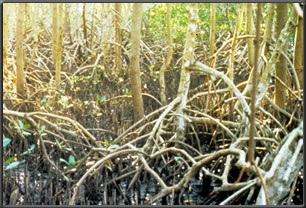Tidal Fringe
 Tidal fringe wetlands occur along coasts and estuaries and are under the influence of sea level. They intergrade landward with riverine wetlands where tidal current diminishes and river flow becomes the dominant water source. Additional water sources may be groundwater discharge and precipitation. The interface between the tidal fringe and riverine classes is where bidirectional flows from tides dominate over unidirectional flow controlled by floodplain slope of riverine wetlands. Because tidal fringe wetlands frequently flood and water table elevations are controlled mainly by sea surface elevation, tidal fringe wetlands seldom dry for significant periods. Tidal fringe wetlands lose water by tidal exchange, by overland flow to tidal creek channels, and by evapotranspiration. Organic matter normally accumulates in higher elevation marsh areas where flooding is less frequent and the wetlands are isolated from shoreline wave erosion by intervening areas of low marsh. Spartina alterniflora salt marshes are a common example of tidal fringe wetlands.
Tidal fringe wetlands occur along coasts and estuaries and are under the influence of sea level. They intergrade landward with riverine wetlands where tidal current diminishes and river flow becomes the dominant water source. Additional water sources may be groundwater discharge and precipitation. The interface between the tidal fringe and riverine classes is where bidirectional flows from tides dominate over unidirectional flow controlled by floodplain slope of riverine wetlands. Because tidal fringe wetlands frequently flood and water table elevations are controlled mainly by sea surface elevation, tidal fringe wetlands seldom dry for significant periods. Tidal fringe wetlands lose water by tidal exchange, by overland flow to tidal creek channels, and by evapotranspiration. Organic matter normally accumulates in higher elevation marsh areas where flooding is less frequent and the wetlands are isolated from shoreline wave erosion by intervening areas of low marsh. Spartina alterniflora salt marshes are a common example of tidal fringe wetlands.
Example Subclasses

Back to HGM Approach
Web Date: October 1997
Updated: February 2022
|

